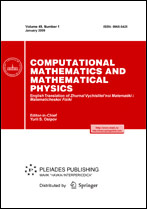|
This article is cited in 4 scientific papers (total in 4 papers)
Optimal control
Regularization of the classical optimality conditions in optimal control problems for linear distributed systems of Volterra type
V. I. Suminab, M. I. Suminab
a Lobachevskii Nizhnii Novgorod State University, 603950, Nizhnii Novgorod, Russia
b Derzhavin Tambov State University, 392000, Tambov, Russia
Abstract:
Regularization of the classical optimality conditions – the Lagrange principle and the Pontryagin maximum principle – in a convex optimal control problem subject to functional equality and inequality constraints is considered. The controlled system is described by a linear functional-operator equation of second kind of the general form in the space $L_2^m$. The main operator on the right-hand side of the equation is assumed to be quasi-nilpotent. The objective functional to be minimized is strongly convex. The derivation of the regularized classical optimality conditions is based on the use of the dual regularization method. The main purpose of the regularized Lagrange principle and regularized Pontryagin maximum principle is to stably generate minimizing approximate solutions in the sense of J. Warga. The regularized classical optimality conditions (1) are formulated as existence theorems of minimizing approximate solutions in the original problem with simultaneous constructive representation of these solutions; (2) are expressed in terms of regular classical Lagrange and Hamilton–Pontryagin functions; (3) are sequential generalizations of the classical analogs, which are limiting versions of the generalizations, while preserving the general structure of the classical analogs; (4) “overcome” ill-posedness properties of the classical optimality conditions and provide regularizing algorithms for solving optimization problems. As an application of the results obtained for the general linear functional-operator equation of second kind, two examples of concrete optimal control problems related to a system of delay equations and to an integro-differential transport equation are discussed.
Key words:
convex optimal control, distributed system, functional-operator equation of Volterra type, ill-posedness, regularization, duality, minimizing approximate solution, regularizing operator, Lagrange principle, Pontryagin maximum principle.
Received: 12.12.2020
Revised: 21.03.2021
Accepted: 07.07.2021
Citation:
V. I. Sumin, M. I. Sumin, “Regularization of the classical optimality conditions in optimal control problems for linear distributed systems of Volterra type”, Zh. Vychisl. Mat. Mat. Fiz., 62:1 (2022), 45–70; Comput. Math. Math. Phys., 62:1 (2022), 42–65
Linking options:
https://www.mathnet.ru/eng/zvmmf11344 https://www.mathnet.ru/eng/zvmmf/v62/i1/p45
|


| Statistics & downloads: |
| Abstract page: | 259 |
|





 Contact us:
Contact us: Terms of Use
Terms of Use
 Registration to the website
Registration to the website Logotypes
Logotypes








 Citation in format
Citation in format 
